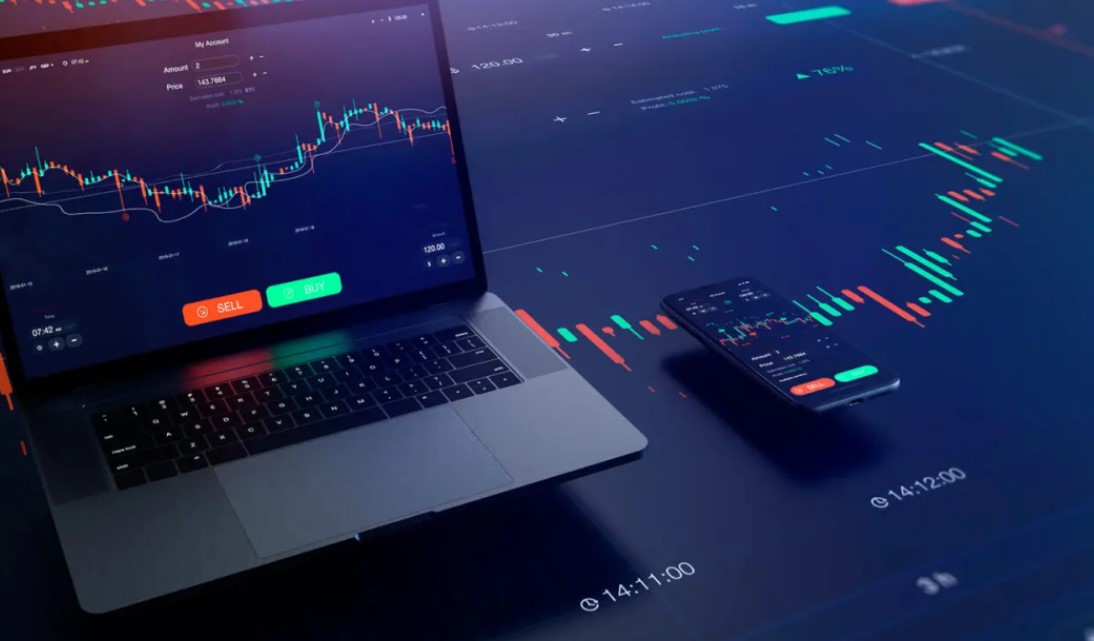
10 minute read
How to Start Forex Trading in Pakistan: A Comprehensive Guide
from Exness
by Exness_Blog
Forex trading, or foreign exchange trading, has gained significant popularity in Pakistan as a way to generate income and build wealth. With the rise of online platforms and access to global markets, Pakistanis are increasingly exploring forex trading as a viable financial opportunity. However, starting forex trading in Pakistan requires careful planning, education, and discipline to succeed in this dynamic and volatile market.
Top 4 Best Forex Brokers in Pakistan
1️⃣ Exness: Open An Account or Visit Brokers 🏆
2️⃣ XM: Open An Account or Visit Brokers 💥
3️⃣ JustMarkets: Open An Account or Visit Brokers ✅
4️⃣ Quotex: Open An Account or Visit Brokers 🌐
In this comprehensive guide, we’ll walk you through everything you need to know about how to start forex trading in Pakistan. From understanding the basics to choosing the right broker, managing risks, and complying with local regulations, this article will equip you with the knowledge to kickstart your forex trading journey.
What is Forex Trading?
Forex trading involves buying and selling currencies on the global foreign exchange market to profit from fluctuations in exchange rates. For example, you might buy US dollars (USD) against the Pakistani Rupee (PKR) if you believe the USD will appreciate in value. The forex market operates 24/5, making it one of the most accessible and liquid markets in the world.
In Pakistan, forex trading is gaining traction due to its potential for high returns and the ability to trade from anywhere with an internet connection. However, success in forex trading requires a deep understanding of the market, technical skills, and a strategic approach.
Why Start Forex Trading in Pakistan?
Before diving into the steps, let’s explore why forex trading is an attractive opportunity for Pakistanis:
· Accessibility: Forex trading platforms are available online, allowing anyone with a smartphone or computer to participate.
· Low Entry Barriers: You can start with a small investment, as many brokers offer accounts with low minimum deposits.
· High Liquidity: The forex market is the largest financial market globally, with trillions of dollars traded daily.
· Flexibility: Trade at your convenience, as the market operates around the clock.
· Potential for Profit: With proper knowledge and strategy, forex trading can be a source of passive or active income.
However, forex trading also comes with risks, including high volatility and potential financial losses. Proper education and risk management are critical to success.
Step-by-Step Guide to Start Forex Trading in Pakistan
Step 1: Understand the Basics of Forex Trading
Before you start trading, take time to learn the fundamentals. Here are key concepts every beginner should know:
· Currency Pairs: Forex trading involves trading currency pairs, such as USD/PKR, EUR/USD, or GBP/JPY. The first currency is the base currency, and the second is the quote currency.
· Pips and Lots: A pip is the smallest price movement in a currency pair, while a lot is the size of a trade (e.g., standard, mini, or micro lots).
· Leverage: Leverage allows you to control a larger position with a smaller amount of capital. For example, 1:100 leverage means you can control $10,000 with just $100. However, leverage magnifies both profits and losses.
· Bid and Ask Prices: The bid price is what buyers are willing to pay, while the ask price is what sellers demand. The difference is called the spread.
· Technical and Fundamental Analysis: Technical analysis involves studying charts and indicators, while fundamental analysis focuses on economic news and events.
To learn these concepts, explore free resources like YouTube tutorials, forex blogs, or eBooks. Websites like Babypips.com offer beginner-friendly courses that cover the essentials.
Step 2: Develop a Trading Plan
A solid trading plan is the foundation of successful forex trading. Your plan should outline:
· Goals: Define whether you’re trading for supplemental income, long-term wealth, or full-time trading.
· Risk Tolerance: Decide how much you’re willing to risk per trade (typically 1-2% of your account balance).
· Trading Style: Choose a style that suits your schedule, such as day trading, swing trading, or long-term trading.
· Strategies: Select strategies based on technical indicators (e.g., moving averages, RSI) or fundamental factors (e.g., interest rate changes).
For example, a beginner in Pakistan might start with a swing trading strategy, holding positions for a few days to capitalize on short-term market trends. Write down your plan and stick to it to avoid impulsive decisions.
Step 3: Choose a Reliable Forex Broker
Selecting the right broker is critical to your success in forex trading. In Pakistan, you should choose a broker that is regulated, user-friendly, and supports local payment methods. Here’s what to look for:
· Regulation: Ensure the broker is regulated by reputable authorities like the FCA (UK), ASIC (Australia), or CySEC (Cyprus). Regulation protects your funds and ensures fair trading practices.
· Trading Platform: Popular platforms like MetaTrader 4 (MT4) or MetaTrader 5 (MT5) are widely used for their advanced charting tools and automation features.
· Account Types: Look for brokers offering micro or cent accounts for beginners with small capital.
· Deposit and Withdrawal Methods: Check if the broker supports local payment methods like bank transfers, JazzCash, or EasyPaisa for easy transactions in Pakistan.
· Customer Support: Opt for a broker with 24/7 support and a local presence or Urdu-speaking representatives.
Some popular brokers for Pakistanis include:
· Exness: Offers fast withdrawals and low minimum deposits.
· XM: Known for low spreads and a user-friendly platform.
· FBS: Provides bonuses and beginner-friendly accounts.
Always research a Ang read reviews on platforms like X or Trustpilot to ensure the broker is trustworthy.

💥 Trade with Exness now: Open An Account or Visit Brokers 🏆
Step 4: Open a Forex Trading Account
Once you’ve chosen a broker, follow these steps to open an account:
· Sign Up: Visit the broker’s website and complete the registration process. You’ll need to provide identification documents for KYC (Know Your Customer) verification.
· Choose an Account Type: Select a micro or demo account to practice trading without risking real money.
· Fund Your Account: Deposit funds using a method convenient for Pakistanis, such as bank cards or mobile payment apps. Be mindful of conversion fees if depositing in PKR.
· Download the Platform: Install MT4, MT5, or the broker’s proprietary platform on your device.
Start with a demo account to practice your strategies without financial risk. Most brokers offer free demo accounts with virtual funds.
Step 5: Learn About Pakistan’s Forex Regulations
In Pakistan, forex trading is legal but operates in a regulatory gray area. The State Bank of Pakistan (SBP) and the Securities and Exchange Commission of Pakistan (SECP) oversee financial activities, but there are no specific laws governing retail forex trading. However, consider the following:
· Capital Controls: Pakistan has restrictions on foreign currency transactions. Ensure your broker complies with SBP regulations for international transfers.
· Tax Implications: Profits from forex trading may be subject to income tax. Consult a tax professional to understand your obligations.
· Reputable Brokers: Stick to regulated international brokers to avoid scams and ensure the safety of your funds.
To stay compliant, use legitimate payment channels and keep records of your transactions.
Step 6: Start Trading with a Demo Account
Before risking real money, practice on a demo account. This allows you to:
· Test your trading strategies in a risk-free environment.
· Familiarize yourself with the trading platform’s features.
· Understand how market news affects currency pairs like USD/PKR.
Spend at least 1-2 months on a demo account to build confidence and refine your skills.
Step 7: Fund Your Live Account and Start Trading
Once you’re comfortable with your demo account, transition to a live account. Start with a small amount you can afford to lose (e.g., $100-$500). Follow these tips:
· Start Small: Use micro lots (0.01 lots) to minimize risk.
· Set Stop-Loss Orders: These limit potential losses by automatically closing trades at a predetermined price.
· Monitor Economic News: Events like US Federal Reserve announcements or Pakistan’s economic policies can impact currency pairs.
· Keep a Trading Journal: Record every trade to analyze your performance and improve over time.
For example, if you’re trading USD/PKR, monitor Pakistan’s economic indicators, such as inflation rates or SBP interest rate decisions, which can influence the rupee’s value.
Step 8: Master Risk Management
Risk management is crucial to long-term success in forex trading. Ascertain the importance of this step. Here are key risk management techniques:
· Risk-Reward Ratio: Aim for trades where potential profits outweigh risks (e.g., 2:1 or 3:1 ratio).
· Position Sizing: Risk only 1-2% of your account balance per trade to avoid significant losses.
· Diversification: Trade multiple currency pairs to spread risk.
· Stop-Loss and Take-Profit Orders: Use these to automate your exit strategy.
For instance, if you have a $1,000 account, risking $10-$20 per trade ensures you can withstand a series of losses without depleting your capital.
Step 9: Stay Educated and Disciplined
Forex trading is a continuous learning process. Stay updated by:
· Following reputable forex educators on platforms like YouTube or X.
· Joining online communities to learn from experienced traders.
· Reading books like Currency Trading for Dummies or Technical Analysis of the Financial Markets.
Discipline is key. Avoid overtrading or chasing losses, as emotional decisions often lead to poor outcomes.
Step 10: Avoid Common Mistakes
Beginners in Pakistan often make these mistakes:
· Overleveraging: Using too much leverage can wipe out your account during volatile market conditions.
· Lack of a Plan: Trading without a strategy leads to inconsistent results.
· Ignoring Fees: Spreads, commissions, and withdrawal fees can eat into profits. Compare brokers to find cost-effective options.
· Emotional Trading: Fear or greed can cloud judgment. Stick to your plan and avoid impulsive trades.
Challenges of Forex Trading in Pakistan
While forex trading offers opportunities, Pakistanis face unique challenges:
· Internet Connectivity: Ensure a stable internet connection, as delays can affect trade execution.
· Currency Conversion Costs: Converting PKR to USD for trading may incur fees. Look for brokers with PKR-based accounts.
· Scams: Beware of unregulated brokers promising unrealistic returns. Always verify a broker’s regulation status.
· Time Zone Differences: The forex market operates on GMT, so major trading sessions (London, New York) may occur at inconvenient times in Pakistan.
To overcome these, choose a broker with local support, test their platform thoroughly, and trade during quieter market hours if your schedule is tight.
Tips for Success in Forex Trading
· Start with Education: Invest time in learning before risking money.
· Use a Demo Account: Practice extensively to build confidence.
· Focus on Risk Management: Protect your capital to stay in the game.
· Stay Patient: Forex trading is a marathon, not a sprint. Consistent small gains add up over time.
· Leverage Technology: Use mobile apps like MT4 or MT5 for on-the-go trading.
Conclusion
Starting forex trading in Pakistan is an exciting opportunity to tap into the global financial markets. By understanding the basics, choosing a reliable broker, practicing on a demo account, and prioritizing risk management, you can build a sustainable trading career. While challenges like currency conversion fees and regulatory ambiguity exist, careful planning and education can help you navigate them.
💥 Note: To enjoy the benefits of the partner code, such as trading fee rebates, you need to register with Exness through this link: Open An Account or Visit Brokers 🏆
Read more:




